Equinox Gold (TSXV: EQX; US-OTC: EQXGF) expects to pour the first gold at its Aurizona open-pit project in northeastern Brazil before year-end.
The past-producing mine — which was put on care and maintenance in 2015 — will be the company’s first operating mine, and construction is fully funded from cash and marketable securities, in addition to a US$85-million secured project credit facility, from which Equinox has drawn US$15 million.
“Things are tracking along nicely so the gold pour is coming up pretty quickly,” Christian Milau, Equinox’s CEO, says in a telephone interview from Vancouver.
Construction is on schedule and on budget, with $43 million of the $146-million construction budget already spent and $76 million committed at the end of March.
The carbon-in-pulp circuit and detox tanks have been refurbished, and the newly built semi-automatic grinding and ball mills and components have been loaded onto a ship to Brazil, with delivery expected in June.
Equinox anticipates a rerating from analysts once it becomes a producer and turns out 136,000 oz. gold a year at estimated all-in sustaining costs of US$754 per oz., over a mine life of six and a half years, based on reserves in the Piaba and Boa Esperanca pits.
The company is working on a resource update that will incorporate near-mine mineralization found in exploration last year. Measured and indicated resources are 1.4 million oz. gold at 1.57 grams gold per tonne.
The mine plan would go down to 200 metres in the pit, but management says there is “significant underground potential,” and is assessing opportunities to develop the deposit underground.
“They’ve been drilling down to about 600 metres below the current pit and hitting the same ore and mineralization, and it’s very competent rock, as you go deeper,” Milau says. “There hasn’t been enough drilling to do enough definition to confirm, but all indications are that it continues to depth. We’ll do a study on that and determine what it might look like, and if we should spend the money on it, and I think the answer will be yes.”
Equinox is also pushing ahead with an exploration program focused on mine life extension and what it describes as “district-scale opportunities.” Equinox is sitting on 4 km of known strike extension that it will test, and the land package is sizeable, at 2,250 square kilometres.

Processing facilities at Equinox Gold’s Aurizona project in Brazil. Credit: Trek Mining, NewCastle Gold.
“These structures continue for kilometres and kilometres, they’re very cohesive and we think we’ll double the mine life through some of the strike extensions along the current structures we’re working on,” Milau says. “Then you step out on these other potential anomalies … there could be satellite deposits or maybe enough there that you would have another mine and another plant. There’s been enough work that indicates the gold is there, so we’re pretty excited about it.”
So far, surface exploration, geophysics and drilling have found a structurally controlled mineralized corridor that includes the Piaba deposit and continues 5 km along strike to the west. Drill targets along the mineralized trend include Piaba West and Tatajuba. Results at Piaba West have confirmed that mineralization extends at least 350 metres along strike to the west, and at depth below the shallow, westernmost reserve pit.
“It’s a huge property that has huge potential,” Milau says. “This area has been mined since the Jesuit’s time in the 1650s, but it has vegetation and it has been underexplored.”
Milau sees similarities between the Aurizona project and parts of West Africa where he and several of his colleagues at Equinox spent time while at True Gold putting the Karma gold mine into production in Burkina Faso. (True Gold was acquired by Endeavour Mining [TSX: EDV; US-OTC: EDVVF] for $240 million.)
“Our property is most similar to Kinross’ Chirano in Ghana in the greenstone belt of West Africa,” he says, referring to the open-pit and underground operation in southwestern Ghana, 100 km southwest of Kumasi, the country’s second-largest city.
“Brazil and West Africa used to be connected and there are the same rock types. You end up with these skinny deposits along structure and a lot of them tend to be steeply dipping, with a similar type of mineralization.”
The rainfall and weathering is also similar, he says.
“Where we are in Brazil you almost feel like you’re in West Africa — the soil, the rock types — give or take 20 years behind in terms of exploration focus and dollars in the north of Brazil. This is an area that just hasn’t been explored, it’s a big country, there’s more ground cover. We’re in an area that has lighter farmland and a little bit of jungle. It feels like that Wild West frontier that hasn’t been explored to depth, and the degree it could have been.”
At the same time, there are a lot of artisanal miners in the area, who dig down to 5 metres and find nuggets, Milau says. “We have photos of nuggets that artisanal miners have found on our property and they range in size from a few kilograms up to as big as 35 kilograms. They’re unbelievable specimens. The artisanal miners find them and machete them up, and divvy them out. You could probably put these nuggets into the Smithsonian.”
While the Aurizona project is considered remote, there is still a paved road to the site and power lines that make the price half of what Milau and his team at True Gold paid for power in West Africa. Brazil also has a lot of skilled labour. “It’s a very mining-focused country,” he says. “It’s a big bureaucratic country and it can be frustrating, but in terms of the geology, it’s fantastic.”
The previous owner of Aurizona, Luna Gold, built and operated the mine for about four years. It went on care and maintenance in the third quarter of 2015. During its last reported year of production in 2013, the mine turned out 79,229 oz. gold at total cash costs of US$723 per oz. gold.
Milau joined Luna Gold in August 2016, along with other True Gold alumni, including David Laing, Equinox’s chief operating officer; Peter Hardie, chief financial officer; Scott Heffernan, executive vice-president of exploration; and Sebastian D’Amici, senior vice-president of finance.
Milau and his colleagues liked the look of Aurizona and the challenge of restarting the mine appealed to them. (At True Gold, they turned around the stalled Karma project and put it into production in just 14 months.)
“We liked challenged projects that had upside and that we could fix with good management,” he says. “And we saw it was 2,200 km in a very prospective greenstone belt, similar to West Africa.”
In August 2016, Milau and other Equinox executives put up $2.3 million of their own money to restart Aurizona.
“That’s how we got started, so there was nothing sinister about why it shut down,” he says. “It has tons of prospectivity and will be around for decades, and it just needed the money.”

The Piaba pit at the Aurizona gold project in Brazil. Credit: Trek Mining.
Luna Gold built Aurizona in 2008–2009, right after the global financial crisis, and it produced 350,000 oz. gold over four years. Luna financed the build with the help of a stream from Sandstorm Gold (TSXV: SSL), Milau says, but it was at 17%, “an exceptionally high number, so it took a lot of profits out the door.”
“It was built on a shoestring at a downtime in the market and they built the plant they could afford … for the first phase of the mine,” Milau says. “It worked reasonably well for about four years, but they always needed to build a front end to the plant, so they never had a crusher, they had an old asbestos mill from Quebec, and they planned to run it for five or six years — run the soft material first, and then once they got to the hard rock, they’d transition and would have to put the right equipment in. But they ran out of money, the gold price started falling and the gold stream was high, so they put it on care and maintenance.”
In addition to Aurizona, Equinox has a joint venture with AngloGold Ashanti (NYSE: AU) on 23 exploration licences, south of the Piaba deposit. These greenfield exploration licences cover 1,800 sq. km, and AngloGold is earning a 70% stake by spending US$14 million on exploration over four years.
The major started exploring in August 2016 and has spent US$6 million to US$7 million so far, flying extensive airborne surveys. Data from the airborne surveys and surface geochemistry helped define drill targets. Last year it drilled 10,000 metres in areas they could access quickly.
“The previous management team before us brought them in … and they certainly went hard at it the first year,” Milau says.
If AngloGold sells its interest in the greenfield property before finishing a resource estimate, AngloGold will return them to Equinox at no cost. If a resource estimate is ready, Equinox can buy AngloGold’s interest for US$10 per ounce.
Elsewhere in South America, Equinox owns a copper-molybdenum porphyry deposit in southeastern Ecuador called the Warintza project. Only a small part of the 226.8 sq. km land package has been tested, with 6,500 metres of drilling. A resource estimate on the project in 2013 outlined an inferred resource of 1.81 billion lb. copper at 0.42% copper and 132.3 million lb. molybdenum at a 0.031% grade, for a copper-equivalent resource of 2.1 billion lb. at 0.61%.
The project lies in a mineralized corridor that hosts numerous porphyry deposits. Warintza is 40 km north of Mirador’s copper-gold development project and nearly contiguous to the Panantza-San Carlos copper project owned by EcuaCorriente, an Ecuadorian subsidiary of China’s CRCC-Tongguan consortium.
In Chile, Equinox owns another copper-molybdenum project called Ricardo. The project’s land package is 160 sq. km located along the West Fissure fault. The company has only drilled two holes so far, but says it has found rock types similar to those seen at Codelco’s enormous Chuquicamata mine, 1,650 km north of Santiago. (Chuquicamata is one of the largest open-pit copper mines in the world (4.3 km long, 3 km wide and 850 metres deep), and has operated since 1910. The operation will become an underground mine sometime in 2019.)
In Peru, Equinox has the Koricancha mill, a custom-built, gold ore-processing facility with a 350-tonne-per-day capacity. It buys mineralized feed from legally operating small-scale and artisanal miners at a market discount, processes it into gold and silver, and sells it at spot prices.
The mill is in southern Peru and 10 minutes from the Pan-American Highway.
The company’s other asset is a 60% stake in the La Verde copper-silver-gold porphyry deposit in Mexico, with a subsidiary of Teck Resources owning the other 40%. The project has been explored only sporadically since 1906, with 115,000 metres of drilling to date. A 2012 resource estimate outlined measured resources of 57.5 million tonnes grading 0.45% copper; indicated resources of 350.4 million tonnes grading 0.40% copper; and inferred resources of 337.5 million tonnes grading 0.37% copper.
Equinox aims to produce 500,000 to 1 million oz. gold annually by the mid-2020s.
Some of that growth likely will come from outside South America, at its advanced-stage Castle Mountain gold project, 120 km south of Las Vegas in California’s San Bernardino county. There was a heap-leach operation there between 1991 and 2001 that produced 1.24 million oz. gold at a head grade of 1.47 grams gold per tonne.
Management expects to finish a prefeasibility study on Castle Mountain by mid-2018.
The project has a measured and indicated resource of 192 million tonnes grading 0.64 gram gold for 4 million contained oz. gold, and another 102 million inferred tonnes averaging 0.48 gram gold for 1.6 million contained oz. gold. The resource estimate used a 0.2 gram gold cut-off grade.
Based on 2017 drilling, Equinox’s geologists reckon that there is “strong organic growth potential” at Castle Mountain.
In addition to Castle Mountain, Equinox also holds the past-producing Elk Gold project in British Columbia.
Equinox’s chairman, Ross Beaty, owns 12% of the company’s outstanding common shares. The mining entrepreneur helped create the company in October 2017 by leading a merger between Trek Mining, NewCastle Gold and Anfield Gold.
On a conference call discussing the merger at the time, Beaty said the opportunity appealed to him for a number of reasons, including impressive core management and a strong board of directors.
“We have two big assets that have the capacity to become large mines with bright futures,” he told analysts and investors on the call. “The assets have near-term, low-cost gold production, and generate high returns. That’s how you create shareholder wealth.”
Equinox has a $500-million market capitalization, with 445 million shares outstanding at $1.10 per share.

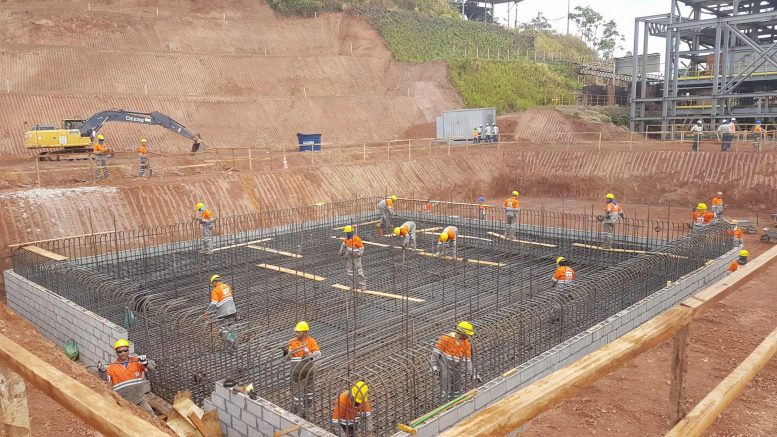
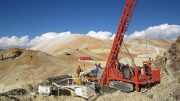
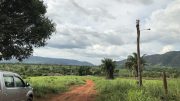
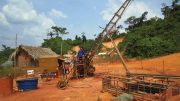
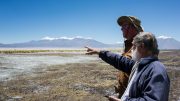
Be the first to comment on "Equinox Gold nears production at Aurizona"